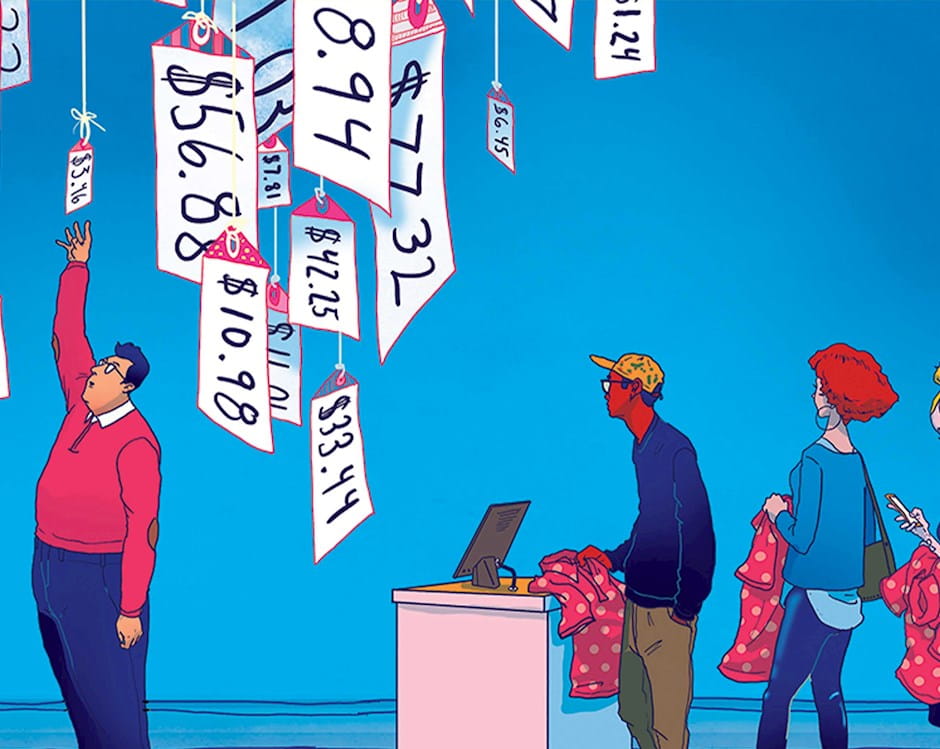
Are You Ready for Personalized Pricing?
Companies are figuring out what individual customers will pay—and charging accordingly.
Are You Ready for Personalized Pricing?Retailers have long set prices ending in 99 cents, knowing that buyers view $4.99, for example, as significantly less expensive than $5. But many companies underestimate consumers’ left-digit bias and should be using these prices more than they do now, according to research by Chicago Booth’s Avner Strulov-Shlain.
Strulov-Shlain analyzed price data from 1,710 popular products in 248 stores of a single US retailer, as well as data on 12 products carried by more than 60 chains and in 11,000 of their stores. He finds that one-quarter to one-third of all prices ended in 99 cents.
But companies tend to miscalculate how customers react to a one-cent price change, Strulov-Shlain asserts. Buyers treat a price increase from $4.99 to $5 as if it were a 15–25 cent increase, while companies behave as if customers respond as though it were a 1.5–3 cent increase.
To learn how much companies should charge, Strulov-Shlain built a model that combines previously established left-digit bias models with a profit-maximizing formula that takes left-digit bias into account. Using the model and retailers’ pricing data, he estimates what price sensitivity and left-digit bias the companies had in mind when setting prices. Many items would have been better priced with a 99-cent ending, because demand dropped when the dollar digit changed, he finds. That was also the case at higher costs, where selling more units for the lower 99-cent price was more profitable than selling fewer units at a higher price.
Left-digit bias can lead to squeezed margins because the cost to manufacture a product might increase but a retailer won’t change the price it charges consumers. For example, even if the cost to make a widget rises from $1.20 to $1.40, a retailer may continue selling it at $2.99 and take a smaller margin. At some point, however, as costs rise, it is better to cross the dollar threshold and raise the price, the research suggests. However, the retailer may raise the price slightly to $3.09, while Strulov-Shlain’s model suggests that such low ending prices are never optimal and that retailers would do better to pick a higher price, even going as high as $3.99.
While it is impossible to say if left-digit bias increases demand or lowers it overall, Strulov-Shlain can evaluate the consequences of underestimating the bias. He evaluated how profits and prices would change if stores set pricing according to the true value of consumers’ left-digit bias as opposed to companies’ much-lower estimation of that bias. He concludes that retailers are forgoing 1–3 percent of potential gross profits due to their misperceptions.
However, the effect on consumers of the retailers’ misperception is ambiguous. The prices of many popular retail goods are actually lowered to the 99-cent level in order to sell more units, which ultimately leads to some benefit for buyers, says Strulov-Shlain. Nonetheless, he argues, by using quantitative modeling, rather than relying on rules of thumb about consumer behavior, companies could significantly improve their bottom lines.
Avner Strulov-Shlain, “More than a Penny’s Worth: Left Digit Bias and Firm Pricing,” Working paper, April 2019.
Your Privacy
We want to demonstrate our commitment to your privacy. Please review Chicago Booth's privacy notice, which provides information explaining how and why we collect particular information when you visit our website.